AN EXCLUSIVE INTERVIEW WITH FLORA BORSI
BY JOSÉ JEULAND
1ST PLACE WINNER | Winner at the International Open Call Competition. A collaboration of Florence Biennale, Art Market Magazine, and Lens Magazine.
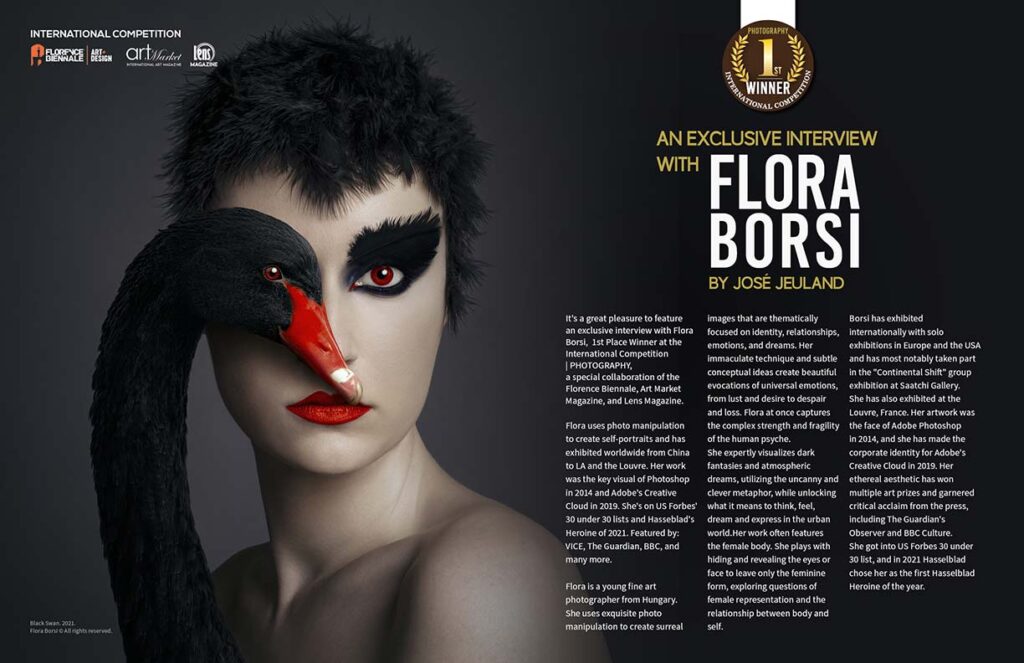
An exclusive interview with Flora Borsi in Lens Magazine Issue #81
It’s a great pleasure to feature an exclusive interview with Flora Borsi, 1st Place Winner at the International Competition
| PHOTOGRAPHY, a special collaboration of the Florence Biennale, Art Market Magazine, and Lens Magazine.
Flora uses photo manipulation to create self-portraits and has exhibited worldwide from China to LA and the Louvre. Her work was the key visual of Photoshop in 2014 and Adobe’s Creative Cloud in 2019. She’s on US Forbes’ 30 under 30 lists and Hasseblad’s Heroine of 2021. Featured by: VICE, The Guardian, BBC, and many more.

Flora Borsi © All rights reserved.
Flora is a young fine art photographer from Hungary. She uses exquisite photo manipulation to create surreal images that are thematically focused on identity, relationships, emotions, and dreams. Her immaculate technique and subtle conceptual ideas create beautiful evocations of universal emotions, from lust and desire to despair and loss. Flora at once captures the complex strength and fragility of the human psyche.
She expertly visualizes dark fantasies and atmospheric dreams, utilizing the uncanny and clever metaphor, while unlocking what it means to think, feel, dream and express in the urban world. Her work often features the female body. She plays with hiding and revealing the eyes or face to leave only the feminine form, exploring questions of female representation and the relationship between body and self.
Borsi has exhibited internationally with solo exhibitions in Europe and the USA and has most notably taken part in the “Continental Shift” group exhibition at Saatchi Gallery.
She has also exhibited at the Louvre, France. Her artwork was the face of Adobe Photoshop in 2014, and she has made the corporate identity for Adobe’s Creative Cloud in 2019. Her ethereal aesthetic has won multiple art prizes and garnered critical acclaim from the press, including The Guardian’s Observer and BBC Culture.
She got into US Forbes 30 under 30 list, and in 2021 Hasselblad chose her as the first Hasselblad Heroine of the year.
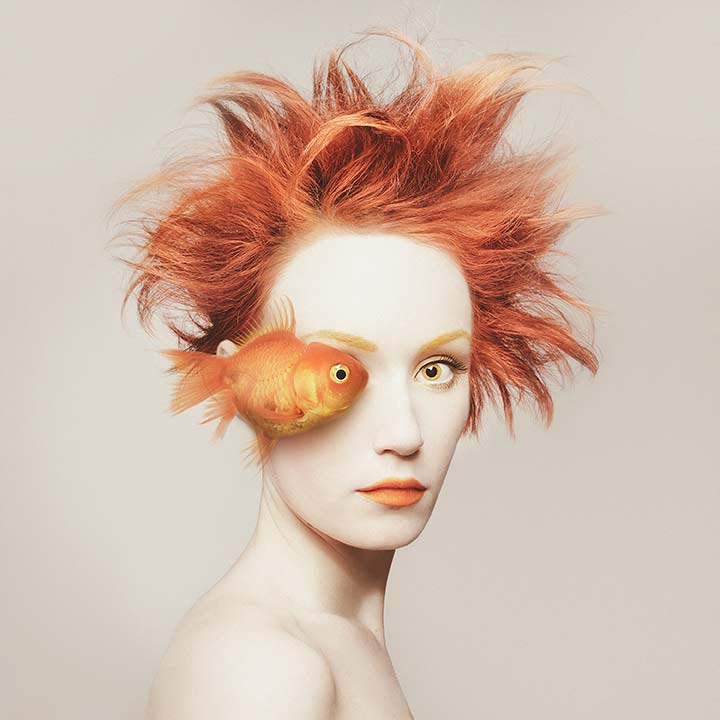
Flora Borsi © All rights reserved.
Conceptual Photography in Flora’s work gets new dimensions. The photographer uses Photoshop to create things that don’t exist in reality but are a reflection of her inner world. Surreal Photography reveals Flora’s emotions, thoughts, and dreams, represented in a thrilling way. She captures portraits and then manipulates with the originals
– by adding subjects or playing with colors. For example, she made portraits of herself with different animals inserted on her face.
Flora Borsi shows us something different, something that is in opposition to reality.
But, the main idea is, actually, to represent the inner reality – the real world of emotion.
For this reason, post-production has a unique role in her work:
“The editing software is just a tool to complete my pictures; I want to make an image, which looks like a real, unedited photo.”
Flora mostly makes self-portraits, facing her emotions and thoughts. She works in a studio, using only one light, avoiding posing in front of the audience. The idea to shoot self-portraits is very productive. It is much easier to pose when you know which emotions you want to catch.
As Flora Mentioned: “Art is therapy for me; this is how I process my emotions like a confession.”
Flora’s photos expose the specific bond between the human body and self. Her work emphasizes the photographer’s aesthetic and main inspiration – a human body presented in a mysterious way.
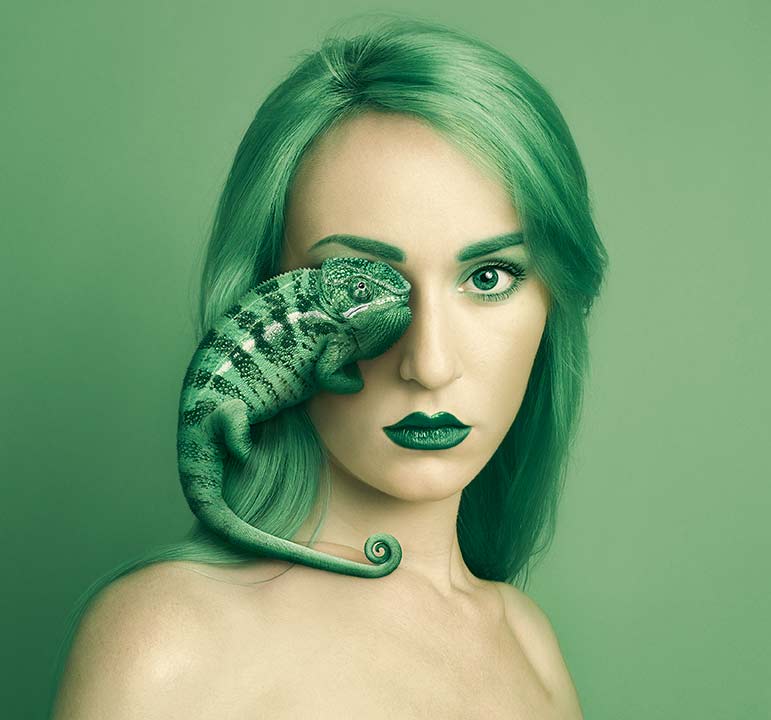
Flora Borsi © All rights reserved.
Lens Magazine: Congratulations, Flora, for being awarded as the 1st place winner at the Contemporary Art and Fine Art Photography’s international competition, A collaboration by Florence Biennale, Art Market Magazine, and
Lens Magazine.
Let’s start at the beginning. Your work has been featured in countless international publications and news channels globally, including at Forbes, BBC Culture, CNN, Daily Mirror, and many others. You have worked with the prestigious Adobe as a representative artist. You worked as the face of Adobe Photoshop in 2014 and made the corporate identity for Adobe’s Creative Cloud in 2019. You have reached a very honorable position worldwide, being represented by art galleries around the globe and internationally awarded respectable prizes.
Please tell our readers what your background is in Art and Photography. Did you have academic studies? Did you come from an artistic family?
Flora Borsi: Thank you. I came from an ordinary family; a few members had artistic veins but never made it to a professional career. My Dad is an engineer, and he is really into anything tech-related, so he taught me the basics of Photography. Although I am a self-taught artist, this was helpful in my younger years to develop such a passion for photo manipulation thanks to overcoming tech-related difficulties during the process. Later on, I decided that I want some higher education in Photography, so I went to the Moholy-Nagy University of Arts and got my Bachelor in Arts a few years ago.
L. M.: Your work received enormous exposure worldwide, with millions of Adobe users got familiar with your art as they were using the creative clouds; your work has been exhibited in galleries and museums all over the world, including at the Duolun MoMA, Shanghai, China, and at the National Museum of Hungary in 2019. What was your journey from being an anonymous fine art photographer to a leading, one of the most influential fine art photographers? Tell us about your path in the field, how it all started?
F. B.: It all started at a young age; I was really interested in art in every form. I used to draw portraits with oil-pastel for many years and have won numerous awards since the age of 7. Later on, around 2013, I made my “Time Travel” series which was a real breakthrough; this series was seen by millions of people, this was the real start of my career. Later I discovered conceptual Photography, and I went in this direction with my self-portraits. I like surrealism very much, and I decided to make portraits mostly around this topic. With years of working and overcoming many obstacles (coming from being a digital artist), I gained critical acclaim, and with many successful stories, I could be who I am today. Popularity and success did not change me as an Artist; maybe I have more self-confidence in the concepts that I want to pursue.
L. M.: What drew you to create photo manipulation in a surrealist style? How would you describe your main artistic style, and do you have an artist/photographer or artistic style that influenced your work?
F. B.: I was trying out almost every field of Photography with various styles, but this one was where I could feel something more than the others. It is like a calling from the unknown, but I am very fortunate because I learned all the basic skills in Photography and Photoshop to visualize every dream-like concept that I have in mind. For me, surrealism is more exciting than creating something that already exists. I wanted to explore the physically impossible visuals and show something to people that would catch their attention more than something that was already seen many times. I started this more than ten years ago, and I can really tell we’re living in some neo-surrealist era; surrealism is thriving again and appearing in many artists’ portfolios; it’s a real trend now.
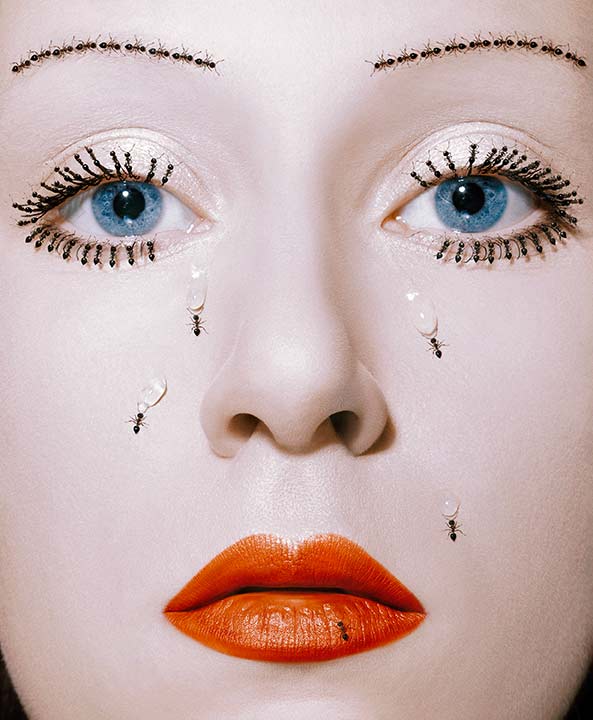
Flora Borsi © All rights reserved.
L. M.: You are very successful on social media channels with hundreds of thousands of followers. Do you post yourself, or do you have a company/studio’s team pushing forward the exposure?
F. B.: Thank you! I’m sharing my work on social media channels since years ago; I think it is more authentic than doing it through a PR company. I want people to follow me for my authentic self, which I communicate through my art, rather than being an influencer who is posting what is expected.
L. M.: Let’s talk about the creation process. Where do the ideas come from? Your work is full of manipulation along with philosophical meaning and quality portraits. Can you explain the messages behind your creativity?
F. B.: These ideas are just popping up in my head; it is like watching a movie stream. I always say that I am some kind of a messenger; I just realize the idea of what’s coming from some higher source. Maybe it is just my brain.
I do not really care about categorizing my inspiration’s source. I think that is my mission – to create art – to make people feel something or reflect on their lives. My main message is always various; I do not like to tell people what they should think or feel while watching my work.
L. M.: You are also your own muse in your photographs; are you doing everything yourself? Makeup, styling, shooting, etc.?
F. B.: I do not consider myself as my own muse. I am just the best tool to complete my ideas and turn them into artwork. Sometimes I wake up in the middle of the night and create an image I have in mind. Sometimes, it’s easier to use me for legal reasons; I don’t want to argue over using rights and licenses. The picture is made from the very beginning to the end all by myself, and I am more confident like this; I feel that I can be more honest through a picture this way than using someone else to convey the message coming from my soul and mind. I do everything by myself, from the makeup to the light set up, shooting to post-production, marketing, and sales.
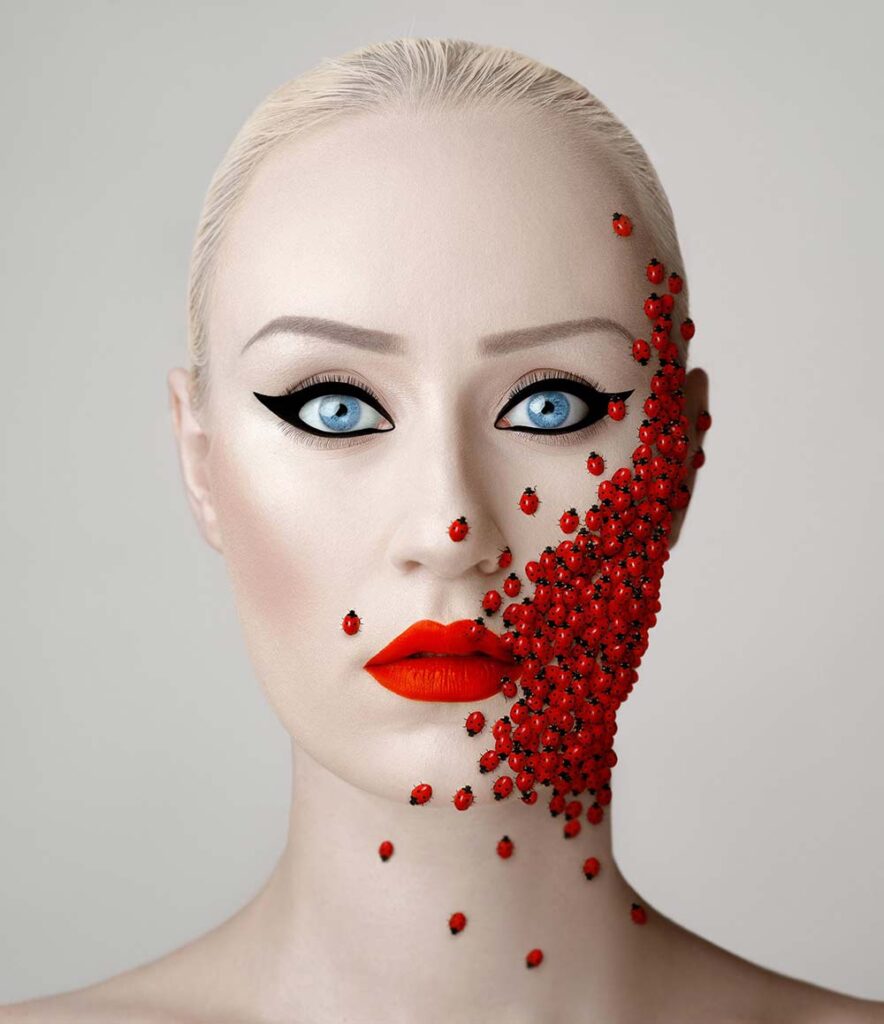
Flora Borsi © All rights reserved.
L. M.: Can you describe the creating process step by step, from the idea to the final outcome? For the manipulation work, what is the average time spent on an image? Which image of yours takes the longest time?
F. B.: I always start with a sketch and some keywords. Sometimes it takes years to create an idea; I always wait for the right time when I feel inspired for a specific concept. When I decide to create a picture, I order all the necessary accessories and everything that the styling needs. Then I arrange everything in my studio, the background, the light shaping, etc.,
and I shoot the self-portrait.
Then long hours of post-production, sometimes it can be a week to create the composite with many elements that I have also taken photos of. The longest for many years was my most recent work with ‘Ladybugs.’ It took seven days to arrange more than 240 ladybugs on my face.
L. M.: What is your favorite image or project?
F. B.: My favorite project is Animeyed; my favorite picture is Black swan from it.

L. M.: You did a manipulation of David Bowie’s photograph taken by the famous portrait photographer Greg Gorman? Do you often collaborate with other photographers? How the collaboration or project come about?
F. B.: When David Bowie died,
I decided to make something to remember him. It was five years ago, so I do not remember clearly, but he had a song with a lyric with a bluebird and its freedom, representing him passing away. I found Greg Gorman’s image and created the photo manipulation, we met with Greg, and I showed him the picture, and he absolutely loved it, and we became friends.
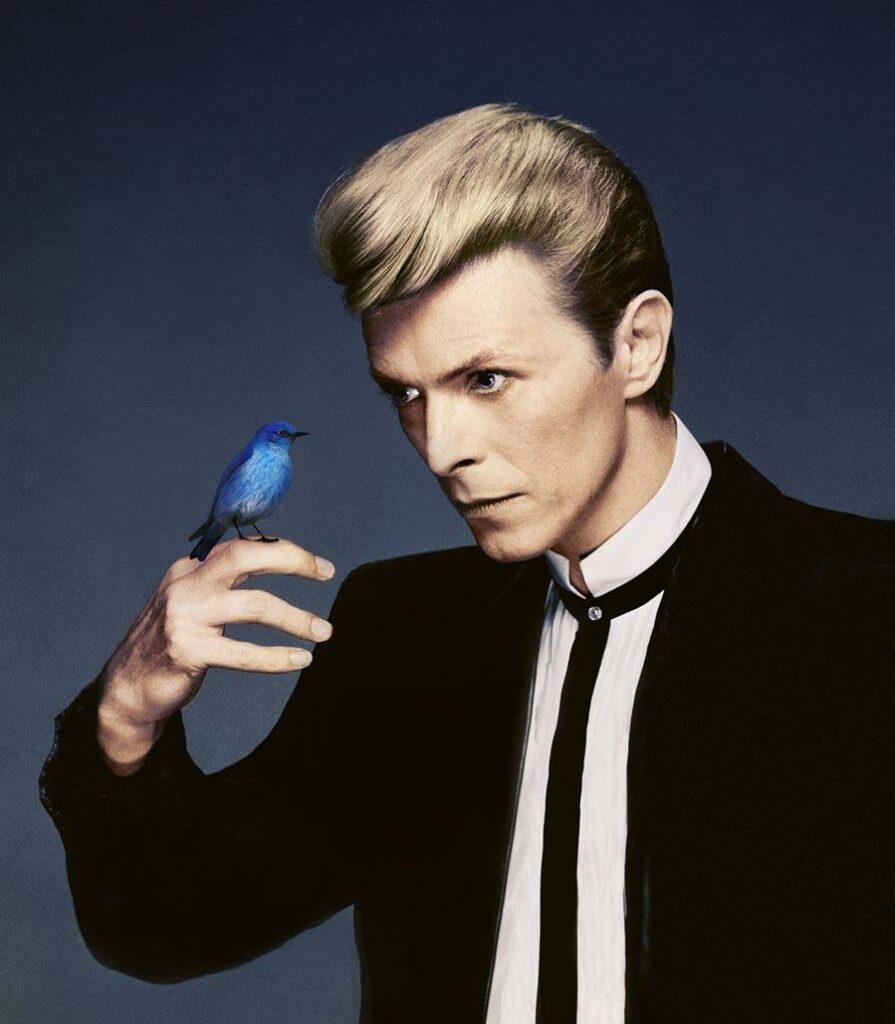
Flora Borsi © All rights reserved.
L. M.: Can an artist manipulate a photograph without the agreement of the photographer?
F. B.: I don’t think that I am the right person to answer this because it’s a comprehensive question to answer. It depends on the artist’s rights, so I don’t want to mislead people with legal advice from an unprofessional source.
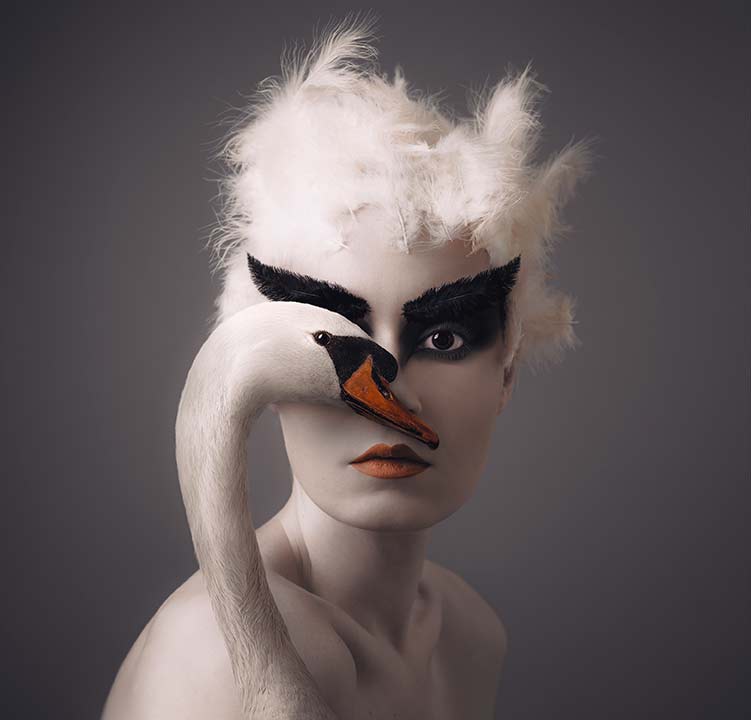
Flora Borsi © All rights reserved.
L. M.: What gear are you using for the portraits? Which apps/ techniques are you using for post-processing?
Do you have your own photography studio?
F. B.: I have my own studio in my living room, so it’s very handy, and I use Hasselblad X1D II 50C with a 45 mm lens and Profoto B1 as a light source. I use Photoshop and Lightroom for post-production.
L. M.: Let’s talk about the Adobe projects. You have done beautiful and impressive projects for Adobe since 2014, where you started creating the artwork for Adobe Photoshop, followed by creating the corporate identity for Adobe’s Creative Cloud in 2019. How is your connection and journey with Adobe began? Are you also helping Adobe with feedback on software or being involved in the development?
F. B.: It has begun with a project in 2014, where they commissioned me with a piece for a large mural about anti-bullying. Later that year, they chose my work as the starting screen of Photoshop. After this, I was selected to be one of the Photoshop 25 under 25 teams, where they chose the most promising 25 Artists under the age of 25. I was one of the beta testers of Photoshop for iPad, and I was fortunate to be in one of their workshops in NYC; it was so fun to see the software before it was published, and we could even work on an iPad which was not released at the time by Apple. I am working for them on a commission basis, sometimes we work together on projects several times in a year, sometimes, we don’t cross each other’s paths for years.

Flora Borsi © All rights reserved.
L. M.: In your opinion, and from your enormous experience as an artistic fine art photographer in the field, what place does surrealistic fine art photography have in the contemporary art market? (In auctions, exhibitions, and art fairs).
F. B.: I think it’s fashionable and trendy to collect surrealist digital artworks both from galleries or in auctions, but it has to be decades to be really valuable like every artwork. It ages like a fine wine; with time, it would worth more. The market likes it as an accessory for a living room, but not something to invest in yet. Film photography is still more valuable than digital artworks, and this has something to do with its form of selling, such as limited editions and copies. Collectors do not like things that can be reproduced; they are more into unique artworks made 50-70 years ago.
L. M.: Are you managing the printing of your art? Do you have a special requirement? Technics? Paper?
F. B.: I am partly managing the printing of my art, and I have a certified printing team at Giclée Factory. I prefer matte photo paper from both Hahnemühle and Tecco Paper. For authenticating, I use a dry stamp, hand signature, and certificate of authenticity.
L. M.: Besides having your images used by Adobe, do you do commercial campaigns?
F. B.: I like to make commercial artworks. I just don’t like revisions and being told what to do, so I collab only with companies who give me the freedom to execute what they had in mind and endorse connections built on trust. For me, the quality of both the workflow and the artwork is more important than the price they pay for it. I rather do a job where I feel inspired than something where I am just the right hand of the employer. For that, companies can use a DTP artist.
L. M.: On the upcoming event of XIII Florence Biennale, which will be held from 23 to 31 October 2021 at Fortezza da Basso in Florence, Italy, under the high patronage of the European Parliament, Your art will be presented in a mass media campaign along with billboards in all over the city. How does this respectable enormous exposure make you feel?

Left to Right: JACOPO CELONA, General Director, Florence Biennale
Dafna Navarro, CEO& Founder, Editor-in-Chief, Lens Magazine & Art Market Magazine
Miguel Bermudez, Art Market Magazine’s journalist (2016-2021)
Flora Borsi, presented at the Florence Biennale
PIERO CELONA, Vice President and Founder, Florence Biennale
GIOVANNI CORDONI, Event Manager, Florence Biennale
F. B.: I do not think that I received such high recognition in many years, so I am incredibly happy and thankful. I just cannot wait to see and experience this. The latest years were very hard, and I didn’t think that life would start over in such a short period of time, so I was flattered when I received the news of the result of this competition.
L. M.: What’s the future hold? Are there any new ideas and projects?
F. B.: I have many ideas and projects; it just extremely hard to keep up with my mind. Post-production, as I mentioned, can take up to many days, and I’m very impatient during this process because I’m always forward ten steps than my hands can operate.
L. M.: What advice will you give to young photographers trying to succeed in the field?
F. B.: I would share my favorite quote from Picasso: “The meaning of life is to find your gift. The purpose of life is to give it away.”

